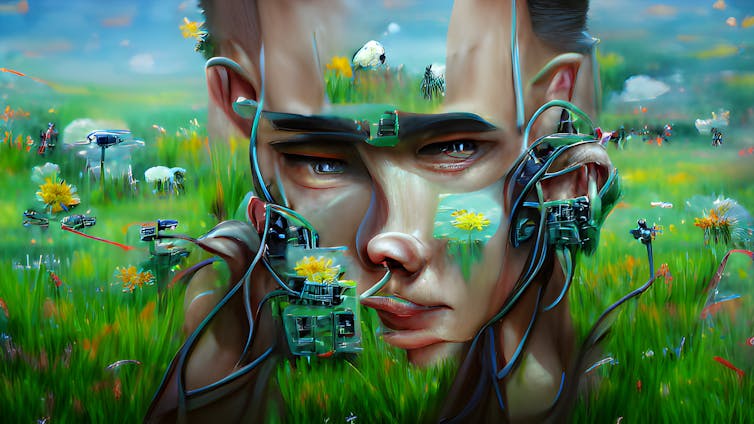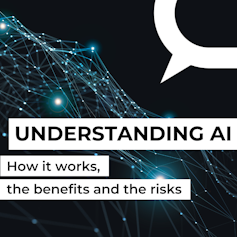In 2022, an AI-generated murals gained the Colorado State Trustworthy’s paintings rivals. The artist, Jason Allen, had used Midjourney – a generative AI system expert on paintings scraped from the net – to create the piece. The strategy was faraway from completely automated: Allen went through some 900 iterations over 80 hours to create and refine his submission.
However his use of AI to win the paintings rivals triggered a heated backlash on-line, with one Twitter client claiming“We’re watching the dying of artistry unfold correct sooner than our eyes.”
As generative AI paintings devices like Midjourney and Safe Diffusion have been thrust into the limelight, so too have questions on possession and authorship.
These devices’ generative talent is the outcomes of teaching them with scores of prior artworks, from which the AI learns how one can create artistic outputs.
Should the artists whose paintings was scraped to teach the fashions be compensated? Who owns the images that AI strategies produce? Is the strategy of fine-tuning prompts for generative AI a kind of real creative expression?
On one hand, technophiles rave over work like Allen’s. Nonetheless on the other, many working artists consider using their paintings to teach AI to be exploitative.
We’re part of a crew of 14 consultants all through disciplines that merely printed a paper on generative AI in Science journal. In it, we uncover how advances in AI will affect creative work, aesthetics and the media. Certainly one of many key questions that emerged has to do with U.S. copyright authorized tipsand whether or not or not they’ll adequately maintain the distinctive challenges of generative AI.
Copyright authorized tips have been created to promote the humanities and creative pondering. Nonetheless the rise of generative AI has refined current notions of authorship.
Pictures serves as a helpful lens
Generative AI could seem unprecedented, nevertheless historic previous can act as a data.
Take the emergence of images inside the 1800s. Sooner than its invention, artists could solely try and portray the world through drawing, painting or sculpture. Impulsively, actuality may probably be captured in a flash using a digital digital camera and chemical substances.
As with generative AI, many argued that footage lacked artistic benefit. In 1884, the U.S. Supreme Courtroom weighed in on the issue and situated that cameras served as devices that an artist could use to supply an thought seen form; the “masterminds” behind the cameras, the courtroom docket dominated, ought to private the photographs they create.
From then on, footage developed into its private paintings form and even sparked new abstract artistic actions.
AI can’t private outputs
Not like inanimate cameras, AI possesses capabilities – like the ability to remodel main instructions into spectacular artistic works – that make it inclined to anthropomorphization. Even the time interval “artificial intelligence” encourages people to suppose that these strategies have humanlike intent and even self-awareness.
This led some people to surprise if AI strategies may be “householders.” Nonetheless the U.S. Copyright Office has mentioned unequivocally that solely individuals can keep copyrights.
So who can declare possession of images produced by AI? Is it the artists whose footage have been used to teach the strategies? The purchasers who kind in prompts to create footage? Or the people who assemble the AI strategies?
Infringement or sincere use?
Whereas artists draw obliquely from earlier works which have educated and impressed them with a objective to create, generative AI will depend on teaching data to provide outputs.
This teaching data consists of prior artworks, a variety of which can be protected by copyright laws and which have been collected with out artists’ data or consent. Using paintings on this way could violate copyright laws even sooner than the AI generates a model new work.

Memo Act, CC BY-SA
For Jason Allen to create his award-winning paintings, Midjourney was expert on 100 million prior works.
Was {{that a}} kind of infringement? Or was it a model new kind of “sincere use,” a approved doctrine that permits the unlicensed use of protected works within the occasion that they’re sufficiently reworked into one factor new?
Whereas AI strategies do not embody literal copies of the teaching data, they do usually deal with to recreate works from the teaching data, complicating this approved analysis.
Will updated copyright laws favor end clients and companies over the artists whose content material materials is inside the teaching data?
To mitigate this concern, some college students counsel new guidelines to protect and compensate artists whose work is used for teaching. These proposals embody a correct for artists to select out of their data’s getting used for generative AI or a technique to routinely compensate artists when their work is used to teach an AI.
Muddled possession
Teaching data, however, is simply part of the strategy. Ceaselessly, artists who use generative AI devices endure many rounds of revision to refine their prompts, which suggests a degree of originality.
Answering the question of who ought to private the outputs requires attempting into the contributions of all these involved inside the generative AI present chain.
The approved analysis is easier when an output is totally completely different from works inside the teaching data. On this case, whoever prompted the AI to provide the output appears to be the default proprietor.
Nonetheless, copyright laws requires vital creative enter – a standard pleased by clicking the shutter button on a digital digital camera. It stays unclear how courts will resolve what this suggests for utilizing generative AI. Is composing and refining a quick adequate?
Points are additional refined when outputs resemble works inside the teaching data. If the resemblance depends solely on regular kind or content material materials, it is unlikely to violate copyright, on account of kind should not be copyrightable.
The illustrator Hollie Mengert encountered this topic firsthand when her distinctive kind was mimicked by generative AI engines in a way that did not seize what, in her eyes, made her work distinctive. Within the meantime, the singer Grimes embraced the tech, “open-sourcing” her voice and provoking followers to create songs in her kind using generative AI.
If an output accommodates most important elements from a chunk inside the teaching data, it’d infringe on that work’s copyright. Simply currently, the Supreme Courtroom dominated that Andy Warhol’s drawing of {{a photograph}} was not permitted by sincere use. That signifies that using AI to easily change the kind of a chunk – say, from {a photograph} to an illustration – should not be adequate to claim possession over the modified output.
Whereas copyright laws tends to favor an all-or-nothing methodology, college students at Harvard Laws College have proposed new fashions of joint possession that allow artists to understand some rights in outputs that resemble their works.
In some methods, generative AI is yet another creative machine that allows a model new group of people entry to image-making, an identical to cameras, paintbrushes or Adobe Photoshop. Nonetheless a key distinction is that this new set of devices relies upon explicitly on teaching data, and subsequently creative contributions cannot merely be traced once more to a single artist.
The strategies by which current authorized tips are interpreted or reformed – and whether or not or not generative AI is appropriately dealt with as a result of the machine it is – may have precise penalties for the way in which ahead for creative expression.

Research what it is good to find out about artificial intelligence by signing up for our publication sequence of 4 emails delivered over the course of each week. You can be taught all our tales on generative AI at TheConversation.com.
